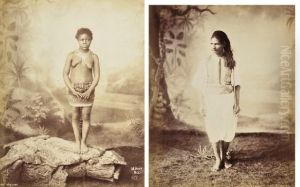Antonio Antoine Beato / Paintings
Antonio Beato, often known as Antoine Beato, was a 19th-century photographer born in Venice to a family of Italian origin around 1832. His exact birth date is not well-documented, and little is known about his early life. He had a brother named Felice Beato with whom he sometimes worked closely. The Beato brothers are among the first photographers to take images of the East and are renowned for their work which provides a comprehensive visual record of many Eastern countries including Egypt, Japan, India, and the Ottoman Empire during the 19th century.
Antonio Beato's photography is particularly associated with Egypt and the Middle East. He moved to Egypt in the 1860s, a time when the country was becoming a place of interest for Europeans due to its ancient history and the opening of the Suez Canal in 1869. Beato settled in Luxor in the early 1870s and operated a studio there. He became well known for his detailed and evocative photographs of Egypt's landscape, ancient monuments, and people. His work was characterized by the careful composition and technical proficiency, making him one of the most prominent photographers of his time in the region.
Beato's work was not limited to still photography. He also produced panoramas, which were particularly popular with tourists and collectors back in Europe. These panoramas often presented a wide view of famous landscapes and cityscapes, providing a sense of the scale and grandeur of the sites. Beato was a savvy businessman and understood the commercial value of his photographs. He sold his work to tourists as souvenirs, to scholars and archaeologists for documentation, and to a broader audience through exhibitions and publications.
Throughout his career, Beato was an intrepid traveler and worked under challenging conditions. His photographs were produced using the collodion process, which required a portable darkroom as the photographic plates had to be coated, exposed, and developed on-site before the collodion dried. This was a complex and delicate process, especially in the heat of the Egyptian climate.
Antonio Beato continued to work in Egypt until his death in Luxor in 1906. His legacy lies in the rich visual documentation he provided, which remains a valuable historical resource. His photographs are not only important records of archaeological sites and cultural heritage but also artistic achievements in their own right. Beato's work has been exhibited and studied extensively, and today his photographs can be found in collections of major museums and institutions around the world.
